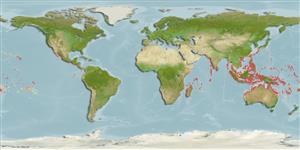Environment: milieu / climate zone / depth range / distribution range
Ökologie
seewasser riff-verbunden; tiefenbereich 0 - 6 m (Ref. 86942). Tropical
Indo-Pacific: Seychelles (Ref. 2334) through the East Indies, Borneo, Philippines, and New Guinea north to Hong Kong and Okinawa and eastward as far as Tuamoto Islands.
Size / Gewicht / Alter
Maturity: Lm ? range ? - ? cm
Max length : 38.0 cm SL Männchen/unbestimmt; (Ref. 54980); common length : 19.0 cm SL Männchen/unbestimmt; (Ref. 9843)
Rückenflossenstacheln (insgesamt): 0; Rückenflossenweichstrahlen (insgesamt): 14-16; Afterflossenstacheln 0; Afterflossenweichstrahlen: 14 - 16; Wirbelzahl: 56 - 60. Prolonged, beak-like lower jaw, contained in 4.2-5.9 times in SL and 0.95-1.4 times in head length; upper jaw short, triangular, and scaly, its width 0.6-0.9 times in its length; length of preorbital bone contained in 1.7-2.2 times in diameter of orbit and 1.0-1.4 times in length of upper jaw. Total number of gill rakers on first arch 33-47; dorsal and anal fin rays 14-16. Caudal fin forked, with lower lobe longer than upper (Ref. 9843).
Most common around islands and coral reefs (Ref. 6041). Found in schools at surface of lagoon and seaward reefs (Ref. 9710, 48635). Marketed fresh and dried salted (Ref. 9843).
Life cycle and mating behavior
Geschlechtsreife | Fortpflanzung | Ablaichen | Eier | Fecundity | Larven
Collette, B.B., 1974. The garfishes (Hemiramphidae) of Australia and New Zealand. Records of the Australian Museum 29(2):11-105. (Ref. 10988)
IUCN Rote Liste Status (Ref. 130435)
Bedrohung für Menschen
Harmless
Nutzung durch Menschen
Fischereien: kommerziell
Mehr Information
NamenSynonymeMetabolismusRäuberÖkotoxikologieFortpflanzungGeschlechtsreifeAblaichenSpawning aggregationFecundityEierEientwicklung
Tools
Zusatzinformationen
Download XML
Internet Quellen
Estimates based on models
Preferred temperature (Ref.
123201): 24.6 - 29.3, mean 28.4 °C (based on 3118 cells).
Phylogenetic diversity index (Ref.
82804): PD
50 = 0.5000 [Uniqueness, from 0.5 = low to 2.0 = high].
Bayesian length-weight: a=0.00257 (0.00115 - 0.00574), b=3.09 (2.91 - 3.27), in cm total length, based on LWR estimates for this Genus-body shape (Ref.
93245).
Trophic level (Ref.
69278): 3.5 ±0.48 se; based on food items.
Widerstandsfähigkeit (Ref.
120179): hoch, Verdopplung der Population dauert weniger als 15 Monate. (Preliminary K or Fecundity.).
Fishing Vulnerability (Ref.
59153): Moderate vulnerability (36 of 100).
Nutrients (Ref.
124155): Calcium = 209 [47, 470] mg/100g; Iron = 0.715 [0.260, 2.500] mg/100g; Protein = 18.2 [15.3, 20.6] %; Omega3 = 0.105 [0.048, 0.313] g/100g; Selenium = 21 [9, 55] μg/100g; VitaminA = 285 [74, 954] μg/100g; Zinc = 1.17 [0.47, 3.22] mg/100g (wet weight); based on
nutrient studies.
